Ozito PXCPPS-018U Handleiding
Ozito
Niet gecategoriseerd
PXCPPS-018U
Bekijk gratis de handleiding van Ozito PXCPPS-018U (3 pagina’s), behorend tot de categorie Niet gecategoriseerd. Deze gids werd als nuttig beoordeeld door 35 mensen en kreeg gemiddeld 4.7 sterren uit 18 reviews. Heb je een vraag over Ozito PXCPPS-018U of wil je andere gebruikers van dit product iets vragen? Stel een vraag
Pagina 1/3

1016
CORDLESS
POLE PRUNER
SAFETY WARNINGS
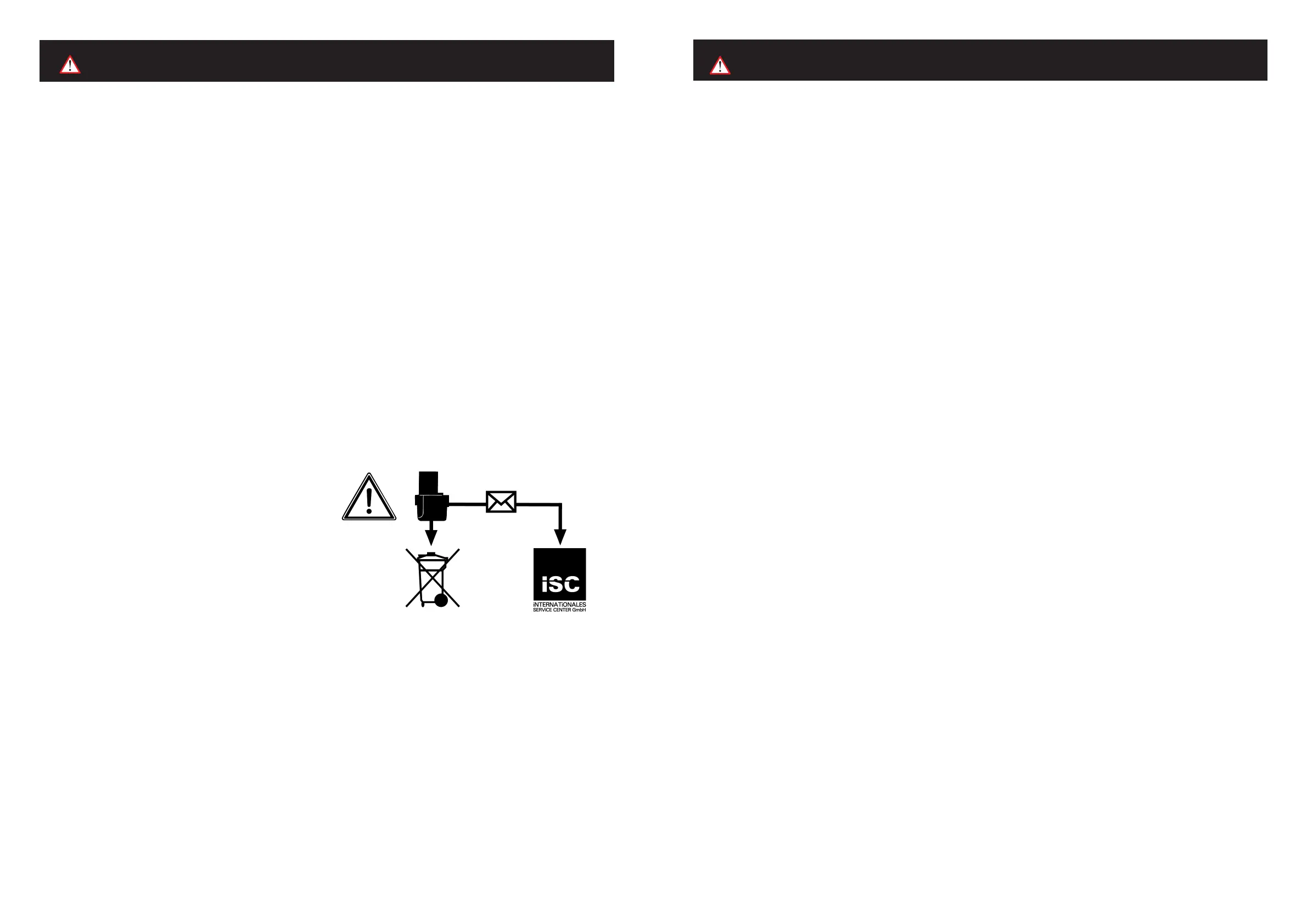
Page 2 Page 3
SPECIAL SAFETY INSTRUCTIONS FOR PRUNER
• Whenthechainsawisrunningmakesurethatyoukeepallpartsofyour
bodyawayfromthechainsaw.Beforestartingupthechainsawmakesure
thatitisnottouchinganything. When you are working with a chainsaw, a
single moment of carelessness is all it takes for clothing or parts of your body to
get caught by the chainsaw.
• Alwaysholdthechainsawsecurelywithyourrighthandontherearhandle
andyourlefthandonthefronthandle. Holding the chainsaw with your hands
in other positions increases the risk of injury and is therefore not allowed.
• Wearsafetygogglesandearprotection.Othersafetyequipmentforthe
head,hands,legsandfeetisrecommended. Correct protective clothing
reduces the risk of injury caused by catapulted chips or in the event of accidental
contact with the chainsaw.
• Neverusethechainsawupatree. You risk injuring yourself if you use the
chainsaw up a tree.
• Alwaysmaintainasteadystandingpositionandonlyusethechainsaw
whenyouarestandingonasolid,safeandatsurface. Slippery or unsafe
surfaces in combination with a ladder can cause you to lose your balance and
control over the chainsaw.
• Whencuttingthroughabranchwhichisundertension,takeintoaccount
howitwillspringbackoncethecuthasbeenmade. Once the tension in the
wood bers is released, the tensioned branch could hit the operator and/or seize
control of the chainsaw.
• Takespecialcarewhencuttingundergrowthandyoungtrees. The thin
material can become caught in the saw chain and whip back towards you or make
you lose your balance.
• Carrythechainsawbythefronthandlewiththechainsawswitchedoffand
thechainfacingawayfromthebody.Alwaysttheprotectivecoverwhen
transportingthechainsaworputtingitintostorage. Careful handling of the
chainsaw reduces the likelihood of accidental contact with the saw chain while it is
running.
• Followtheinstructionsforlubrication,chaintensionandreplacementof
accessories.A chain which is not properly tensioned or lubricated can either
break or increase the risk of kickback.
• Keepthehandlesdry,cleanandfreefromoilandgrease.Greasy or oily
handles are slippery and will result in loss of control.
• Onlyusethechainsawtocutwood.Thechainmustonlybeusedto
performtheworkforwhichitisintended.Forexample:Neverusethe
chainsawtocutplasticorbrickworkorbuildingmaterialswhicharenot
madeofwood.Use of the chainsaw for non-intended or non-approved work can
create dangerous situations.
• Holdtheequipmentonlybytheinsulatedhandleswhencarryingoutwork
duringwhichthecuttingtoolcouldstrikeconcealedpowercables. Contact
with a live cable will also make the metal parts of the tool live and will cause an
electric shock.
Causesofandwaystoavoidrecoil.
Recoil can occur if the tip of the chain bar touches an item or if the wood bends and
jams the saw chain in the cut. In many cases contact with the bar tip can result in an
unexpected reaction aimed backwards in which the chain bar is catapulted upwards
towards the operator.
Jamming the saw chain on the top of the chain bar can catapult the bar towards the
operator at high speed.
Any of these reactions can result in you losing control over the saw and possibly suff
ering serious injuries. You should therefore not rely totally on the safety equipment
tted to the chainsaw. When using a chainsaw you should take various precautions to
enable you to work without suffering accidents or injuries.
Recoil is the result of incorrect or wrong use of the electric tool. It can be prevented by
suitable precautions, as described below:
• Holdthesawrmlywithbothhands,withngersandthumbsgripped
aroundthehandles.Steadyyourselfwithyourbodyandarmsinaposition
inwhichyoucancontrolthekickbackforces. Provided appropriate measures
are taken, an operator should be capable of controlling the kickback forces. Never
let go of the chain saw.
• Avoidabnormalworkingpostures.Nevercutaboveshoulderheight.This
prevents accidental contact with the tip of the rail and offers better control over the
chainsaw in unexpected situations.
• Alwaysusethecorrectreplacementrailsandsawchainsrecommended
bythemanufacturer.The use of incorrect replacement rails or saw chains may
result in breakage of the chain and/or kickback.
• Followthemanufacturer’sinstructionsforsharpeningandmaintainingthe
sawchain.The risk of kickback is increased if the depth limiter is set too low.
Moreimportantinformation:
¥ Before you start felling branches: Make sure that there is nobody within a range of
at least two and a half times the length of the branch.
¥ Take the weather conditions into account when felling trees. Do not fell trees in
strong or gusting wind. Do not fell trees in frost conditions or on frozen, icy ground.
Do not fell trees in rain or if visibility is poor.
¥ Comply with local regulations.
¥ Plan an escape route from falling trees or branches in advance. Make sure
that this escape route is free of obstacles which could restrict or prevent free
movement. Keep in mind that freshly cut grass or bark is slippery.
¥ Ensure that somebody is in the vicinity (but at a safe distance) in case of an
accident.
¥ When the chain is moving, do not let the tip of the chain bar come into contact
with any objects.
¥ Start sawing only after the chain has reached full speed.
¥ Never try to target a previous cut. Always start a new cut.
¥ Watch out for moving branches or other forces which could interfere with a cut
and impact with the chain.
¥ Never try to cut a branch with a larger diameter than the cutting length of the
equipment.
¥ Contact your local government ofces for information regarding minimum age
require ments for operating the equipment.
¥ Keep the equipment at a minimum distance from overhead power cables.
¥ Before you begin your work, make yourself well acquainted with all the control
elements. Practice handling the equipment and have an expert explain its
functions, mode of operation and sawing techniques.
¥ Never use the equipment if you are ill, tired or under the inuence of alcohol or
medication. Always take timely breaks from your work. Change your working
position regularly.
Warning!
If the equipment is used for a lengthy period, the vibrations it causes in the hands of
the user may result in circulation problems (white nger syndrome).
White nger syndrome is a vascular disease that involves seizure-like spasms of the
ngers and toes. The aff ected areas are no longer suf ciently supplied with blood and
therefore appear extremely pale. The frequent use of vibrating equipment may trigger
nerve damage in people with an impaired circulation (for example smokers, diabetics).
Should you observe any unusual impairments, interrupt your work immediately and
consult a doctor.
Follow these instructions in order to reduce the dangers:
¥ Keep your body and in particular your hands warm when working in the cold.
¥ Take regular breaks and move your hands to stimulate the blood circulation during
the breaks.
¥ Ensure that the equipment makes the least possible vibration through regular
maintenance and solid parts on the equipment.
Donotlosethissafetyinformation.
Information about the battery
1. The battery pack supplied with your cordless tool is not charged. The battery
pack has to be charged before you use the tool for the rst time.
2. For optimum battery performance avoid low discharge cycles. Charge the
battery pack frequently.
3. Store the battery pack in a cool place, ideally at 15°C and charged to at least
40%.
4. Lithium-ion batteries are subject to a natural ageing process. The battery
pack must be replaced at the latest when its capacity falls to just 80% of its
capacity when new. Weakened cells in an aged battery pack are no longer
capable of meeting the high power requirements and therefore pose a safety
risk.
5. Do not throw battery packs into an open re. There is a risk of explosion!
6. Do not ignite the battery pack or expose it to re.
7. Donotexhaustivelydischargebatteries. Exhaustive discharge will
damage the battery cells. The most common cause of exhaustive discharge
is lengthy storage or non-use of partly discharged batteries. Stop working
as soon as the performance of the battery falls noticeably or the electronic
protection system triggers. Place the battery pack in storage only after it has
been fully charged.
8. Protectbatteriesandthetoolfromoverloads. Overloads will quickly
result in overheating and cell damage inside the battery housing without this
overheating actually being apparent externally.
9. Avoiddamageandshocks. Replace batteries which have been dropped
from a height of more than one meter or which have been exposed to violent
shocks without delay, even if the housing of the battery pack appears to be
undamaged. The battery cells inside the battery may have suff ered serious
damage. In this respect, please also read the waste disposal information.
10. If the battery pack suff ers overloading and overheating, the integrated
protective cut-off will switch off the equipment for safety reasons. Important.
Do not press the ON/OFF switch any more if the protective cut-off has
actuated. This may damage the battery pack.
11. Use only original battery packs. The use of other batteries may result in
injuries, explosion and a re risk.
Information on chargers and the charging process
1. Please check the data marked on the rating plate of the battery charger.
Be sure to connect the battery charger to a power supply with the voltage
marked on the rating plate. Never connect it to a diff erent mains voltage.
2. Protect the battery charger and its cable from damage and sharp edges.
Have damaged cables repaired without delay by a quali ed electrician.
3. Keep the battery charger, batteries and the cordless tool out of children’s
reach.
4. Do not use damaged battery chargers.
5. Do not use the supplied battery charger to charge other cordless tools.
6. In heavy use the battery pack will become warm. Allow the battery pack to
cool to room temperature before commencing with the charging.
7. Donotover-chargebatteries. Do not exceed the maximum charging times.
These charging times only apply to discharged batteries. Frequent insertion
of a charged or partly charged battery pack will result in over-charging and
cell damage. Do not leave batteries in the charger for days on end.
8. Neveruseorchargebatteriesifyoususpectthatthelasttimetheywere
chargedwasmorethan12monthspreviously.There is a high probability
that the battery pack has already suffered dangerous damage (exhaustive
discharge).
9. Charging batteries at a temperature below 10°C will cause chemical damage
to the cell and may cause a re.
10. Do not use batteries which have heated during the charging process, as the
battery cells may have suff ered dangerous damage.
11. Do not use batteries which have suff ered curvature or deformation during
the charging process or which show other non-typical symptoms (gassing,
hissing, cracking,…)
12. Never fully discharge the battery pack (recommended depth of discharge max.
80%) A complete discharge of the battery pack will lead to premature ageing
of the battery cells.
13. Never charge the batteries unsupervised.
Protection from environmental influences
1. Wear suitable work clothes. Wear safety goggles.
2. Protectyourcordlesstoolandthebatterychargerfrommoistureand
rain. Moisture and rain can cause dangerous cell damage.
3. Do not use the cordless tool or the battery charger near vapors and
inammable liquids.
4. Use the battery charger and cordless tools only in dry conditions and an
ambient tempe- rature of 10-40°C.
5. Do not keep the battery charger in places where the temperature is liable to
reach over 40°C. In particular, do not leave the battery charger in a car that is
parked in the sunshine.
6. Protectbatteriesfromoverheating.Over- loads, over-charging and
exposure to direct sunlight will result in overheating and cell damage. Never
charge or work with batteries which have been overheated – replace them
immediately if possible.
7. Storageofbatteries,batterychargersandcordlesstools. Store the
charger and your cordless tool only in dry places with an ambient temperature
of 10-40°C. Store your lithium-ion battery pack in a cool, dry place at a
temperature of 10-20°C. Protect them from humidity and direct sunlight. Only
place fully charged batteries in storage (charged at least 40%).
8. Prevent the lithium-ion battery pack from free- zing. Battery packs which were
stored below 0°C for more than 60 minutes must be dispo- sed of.
9. When handling batteries beware of electro- static charge: Electrostatic
discharges cause damage of the electronic protection system and the battery
cells. Avoid electrostatic char- ging and never touch the battery poles.
Rechargeable batteries and cordless electricmachines and tools contain materials
that are potentiallyharmful to the environment. Never placeany cordless electric
machines or tools in your household refuse. When cordless electric machines or
tools become defective or worn, remove the rechargeable batteries and return
them to iSC GmbH (address: Eschenstrasse 6, D-94405, Germany). If the
rechargeable batteries cannot be removed, return the complete cordless machine
or tool.
You can then be sure that the equipment will be correctly disposed of by the
manufacturer.
Whenshippingordisposingofbatteriesandcordlesstools,alwaysensure
thattheyarepackedindividuallyinplasticbagstopreventshortcircuits
andres.
Residualrisks
Even when the tool is used as prescribed it is not possible to eliminate all
residual risk factors. The following hazards may arise in connection with the tool’s
construction and design:
1. Damage to lungs if an effective dust mask is not worn.
2. Damage to hearing if effective hearing protection is not worn.
3. Health defects resulting from vibration emission if the appliance is being
used over longer period of time or not adequately managed and properly
maintained.
WARNING! This machine produces an electromagnetic eld during operation.
This eld may under some circumstances interfere with active or passive
medical implants. To reduce the risk of serious or fatal injury, we recommend
persons with medical implants to consult their physician and the medical
implant manufacturer before operating this machine.
Donotlosethesesafetyinstructions.
BATTERY AND CHARGER SAFETY WARNINGS
Product specificaties
| Merk: | Ozito |
| Categorie: | Niet gecategoriseerd |
| Model: | PXCPPS-018U |
Heb je hulp nodig?
Als je hulp nodig hebt met Ozito PXCPPS-018U stel dan hieronder een vraag en andere gebruikers zullen je antwoorden
Handleiding Niet gecategoriseerd Ozito
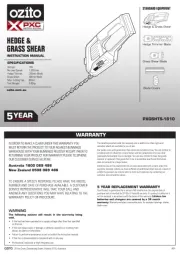
15 Augustus 2025
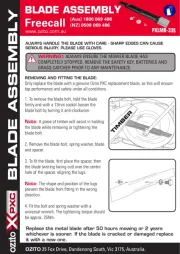
14 Augustus 2025
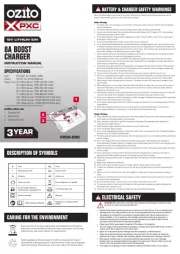
30 Juli 2025
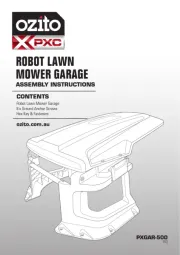
29 Juli 2025
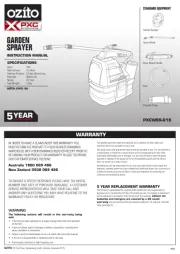
3 Juli 2025
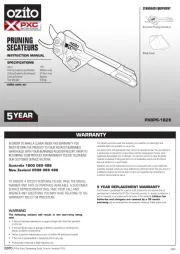
3 Juni 2025

10 December 2024

2 November 2024

8 April 2024

8 April 2024
Handleiding Niet gecategoriseerd
- Volvo
- Terratec
- Creality3D
- Vulcan
- Ives
- Barber Tech
- Raidsonic
- Vurkcy
- Blaze
- Global
- Prido
- Vipack
- Babyzen
- Moki
- Odisei Music
Nieuwste handleidingen voor Niet gecategoriseerd

14 September 2025

14 September 2025

13 September 2025

13 September 2025

13 September 2025

13 September 2025

13 September 2025

13 September 2025

13 September 2025

13 September 2025